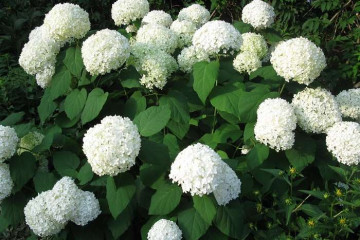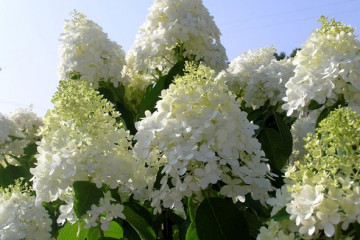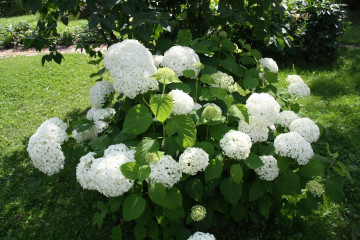Hydrangea Prim White - description, planting and care
Content:
Hydrangea paniculata Prim White stands out for its snow-white inflorescences among other representatives of the species. She blooms one of the first on the site and pleases her owners. When the best conditions are created, it can surprise with repeated flowering.
Description of the variety hydrangea Prim White
Hydrangea paniculata Prim White (Hydrangea paniculata Prim White) is classified as a deciduous shrub. The crop is a descendant of the Dharuma cultivar.
The Latin name of the Prim White variety is read in different ways in Russia, the spelling of hydrangea paniculata Prim White or Prim White is considered correct. If we turn to a translator, the name of the plant will be “Prim White”, which immediately indicates the main characteristic of the variety.
Hydrangea grows up to 1.5 m in height and up to 2 m in diameter. The crown is symmetrical, thin shoots of a grayish color. Pale green foliage is located on reddish petioles.
Paniculate inflorescences, consist of two types of flowers: fertile and sterile. The former are localized in the center, small in size, the latter are distinguished by snow-white petals, which eventually change their shade to greenish or pink.
The description indicates that Prim White hydrangea is frost-resistant, only young bushes can be affected by frosts of -30 degrees. This characteristic makes it possible to grow the variety in most regions of Russia.
Planting and further care
The plant is planted in the northern regions in the spring, in the warm - in the spring or autumn months, if desired.
Site selection and preparation
Shrub care begins with choosing the right place. Choose the following soil:
- well drained;
- sufficiently moisturized;
- loamy, with an acidic or slightly acidic reaction.
Culture loves sunlight, but direct sunlight can cause foliage burns. Therefore, a little shading is considered the best solution.
How to plant
Landing requires compliance with the rules:
- the gap between the bushes is not less than 1 m;
- the root collar is located at ground level;
- landing hole 30 * 30 cm;
- 1/3 of a bucket of peat and humus is introduced into the hole.
After carefully placing the seedling, the voids are filled with earth and watered abundantly.
Hydrangea care
Moistening the soil is carried out with rain or settled water, after each procedure, loosening is done. One-time overflow is allowed, but the soil does not dry out.
For feeding, a manure solution (1 to 10) and a mineral fertilizer consisting of superphosphate (20 g), potassium and ammonium sulfur (10 g each) and 10 liters of liquid are used. The procedure is repeated after 2 weeks.
To rejuvenate the shrub, it is necessary to radically cut the shoots to 0.5-0.8 m. Removal of inflorescences takes place in the autumn.
In late autumn, the trunk circle is mulched with a mixture of peat and humus. The height of the mulch should be more than 30 cm in height.
Young shrubs (up to 3 years old), with the threat of severe frosts, are completely covered with agrofibre. At the same time, an impressive snowdrift is poured under the hydrangea.
Reproduction
The characteristics of the variety indicate that the receipt of new shrubs is carried out with the help of:
- green cuttings - from May to July (rooting rate reaches 90%);
- from February to June - lignified shoots.
Diseases and pests
The plant is characterized by a high level of immunity; it does not require prophylactic treatment with insecticides. If the rules for watering are violated, the shrub may be affected by:
- viral ring spot;
- powdery mildew;
- peronosporosis;
- gray rot.
Treatment consists in pruning the affected shoots and treating the entire aerial part with fungicides. You can find the right products at any gardening store.
Use in landscape design
The perennial is introduced into groups with long-lived crops. The plant can also be used as a tapeworm.
Hydrangea Prim White is an unpretentious shrub that can be used to decorate any garden plot. Domestic gardeners definitely need to pay attention to this plant.



















